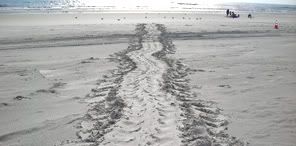
St. Johns County Habitat Conservation Coordinator Tara Dodson reported to Historic City News that the first leatherback turtle nests have been spotted and she is asking for beach drivers to limit their driving at night and early morning hours.
Even though Sea Turtle Nesting Season does not officially begin until May 1, St. Johns County officials have discovered two leatherback nests on St. Johns County beaches.
On Thursday, April 2, and Saturday, April 4, a County beach employee was conducting the routine early morning beach run to clear debris and maintain the driving lane when he discovered a nest each day. A nearby fisherman confirmed the first leatherback sea turtle had exited the beach and re-entered the ocean around 5:30 Thursday morning.
To minimize negative impacts to nesting sea turtles and their hatchlings, St. Johns County is federally mandated to implement a Habitat Conservation Plan (HCP) and Incidental Take Permit (ITP) through the US Fish and Wildlife Service. As part of the HCP, during sea turtle nesting season beach gates will close at 7:30 pm and reopen to vehicular traffic at 8:00 am to cause less disruption to turtles nesting overnight.
However, the official nesting season does not begin until May 1 and officially ends on October 31.
Because nests have been documented prior to the official start of sea turtle nesting season and the restricted beach driving times are not yet in effect, County officials are asking residents and visitors to reduce beach front lighting and limit their time driving on the beach at night as well as early mornings. This will help alleviate any negative impact to nesting sea turtles.
Historically, leatherbacks such as these nest earlier in the season than loggerhead and green sea turtles. Leatherbacks, like green sea turtles, are federally listed as endangered species, while loggerheads are listed as threatened. Sea turtles will return to their natal beach to nest up to five times in one nesting season, but leatherbacks will nest an average of every ten days. This means these nesting females will likely return to the beach to nest again, and other leatherbacks may appear early as well.
Discover more from HISTORIC CITY NEWS
Subscribe to get the latest posts sent to your email.

